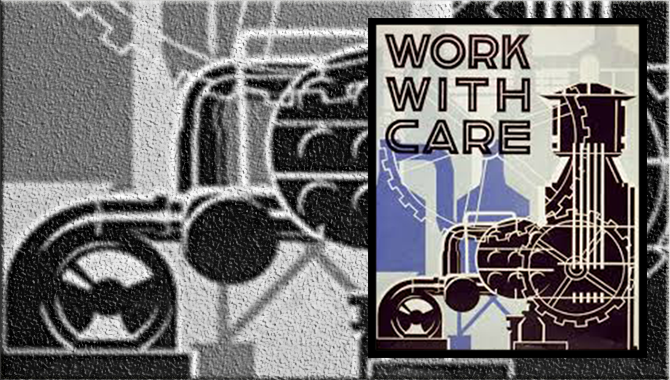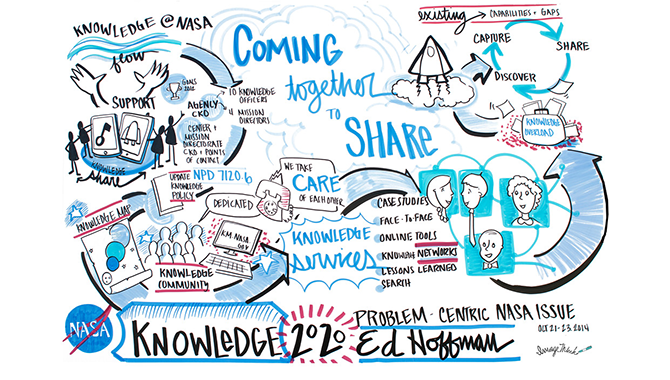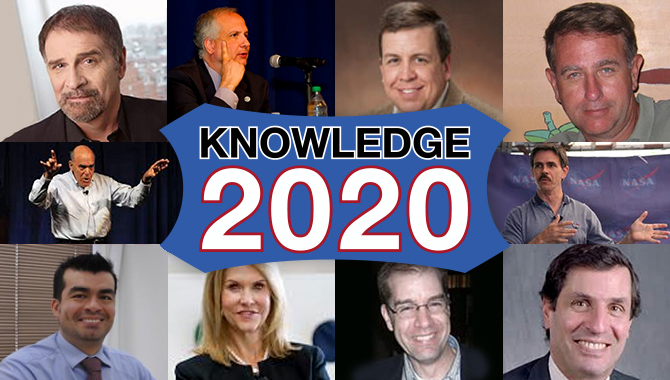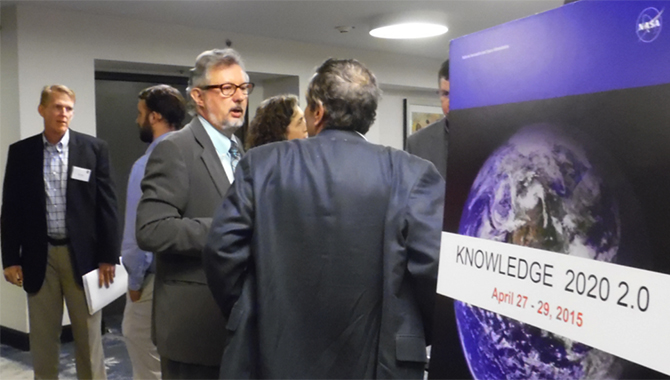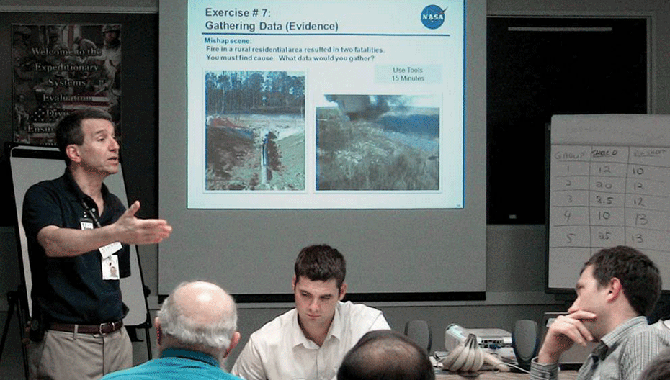
NSC Process Improvement and Implementation Manager Mark George teaches a class on Root Cause Analysis for mishap investigators.
Photo Credit: US Navy
Between 2011 and 2014, the Safety and Mission Assurance (SMA) community has seen an 11 percent net reduction in its workforce — more than twice the five percent agency-wide average.
Although SMA continues to hire from outside and to transfer employees from other NASA organizations, those leaving SMA—through rotation, transfer or retirement—are taking a significant amount of knowledge with them.
John Marinaro, director of the NASA Safety Center’s (NSC) Technical Excellence Office (TEO), estimates that the civil servants leaving SMA had an average of 15 years more SMA experience than those replacing them. The Office of the Chief Knowledge Officer interviewed him to ask how SMA has been rising and will continue to rise to the challenge of the potential loss of knowledge.
How important is it that SMA retain the knowledge necessary to continue ensuring safety and mission success?
NASA needs to maintain a strong SMA capability, or we could get caught by surprise. We need to focus on sustaining a healthy balance of senior, mid-career and new safety engineers in the agency workforce. Right now, NASA is hard at work on the Space Launch System, commercial crew partnerships, James Webb Space Telescope and an array of smaller projects. In a few years, SMA will need to complete a variety of very difficult and vital evaluations to approve these missions for launch. These evaluations require the knowledge of senior subject matter experts with years of experience. The only way you can determine the safety of a mission is with an experienced, senior SMA workforce.
How are you capturing knowledge before it walks out the door?
The NASA Safety Center has several channels for capturing SMA knowledge and sharing it across the agency. Our Knowledge Byte video series gives NASA’s SMA staff the opportunity to share success stories, best practices and other tacit information with peers in 3 to 5 minutes. For instance, we filmed a series of Knowledge Bytes with former OSMA Chief Bryan O’Connor before his departure and another series with former chief scientist for orbital debris Nick Johnson prior to his retirement. We also work with the centers to document Best Practices identified during SMA audits and share those practices on our website. We collect mishap information in the NASA Mishap Information System, analyze it for trends and share those trends in the form of mishap data reports and annual mishap summaries to help centers identify risk based on agency trends. We also facilitate discussions about success stories and lessons learned through live knowledge-sharing events like our SMA Discussion Forum series.
How can you bridge this knowledge gap?
With nearly 21 percent of the workforce having less than four years of experience in SMA, I see an opportunity to focus on training employees, both new hires and engineers new to SMA. You don’t just add water to a great engineer and make them a great safety engineer. We need to focus on developing new SMA employees. Even without the changes to the workforce, SMA faces a unique challenge in that very few schools offer degrees in safety engineering. The lack of formal education options means many employees are left to learn on the job. For years, TEO has been hard at work developing training to engage, educate and advance the SMA workforce. The SMA Technical Excellence Program (STEP) is a career-oriented training program focused on six disciplines; it also has additional curriculums for those with cross-discipline or leadership interests. The voluntary program includes academics, on-the-job training, enrichment experiences and reading materials, as well as a variety of evaluative methods to ensure participants have achieved the necessary competencies.
How are you leveraging relationships with the knowledge and training communities?
TEO has leveraged relationships with the National Safety Council, Reliability Information Analysis Center, Defense Acquisition University and other individual training vendors for additional training. These training opportunities provide supervisors and managers with the resources needed to manage and train a new and changing workforce. Although training has the potential to help bridge the gap between the old and the new workforce, getting employees trained has its own challenges.
We also leverage relationships with the Department of Defense and other government agencies to inform employees through less formal channels. The Safety and Health Learning Alliance (SHLA) is a network of government safety and health professionals we formed to accelerate learning, establish networking opportunities, and create a forum for collaboration on important topics and issues. The alliance holds several knowledge-sharing events each year.
How do employees find time to train?
Time is our biggest challenge. Employees just don’t have a lot of time for training. To make STEP as easy and accessible as possible, most of it is online and available 24 hours a day, seven days a week. The program also doesn’t require seasoned professionals to start from scratch—employees can apply for Equivalence to avoid repetition in training. Equivalence is the process by which prior training and experience is evaluated to determine if it adequately meets the objectives of STEP courses in Levels 2-4.
How successful have you been so far?
At this time, 80 percent of SMA civil servants have graduated from STEP Level 1, but Level 1 is only an introduction to SMA. In the past five years, 50 percent of the NASA SMA civil servant workforce has completed more than 74,000 hours of STEP Level 2-4 training courses and on-the-job training sessions. To truly build individual and organizational SMA competencies, employees need to put in the time and effort to complete the advanced STEP Levels. Ideally, I would like to see 5-10 percent of the civil servant SMA workforce at Level 4 and 40 percent at both Levels 2 and 3. As Stephen Covey points out in the “7 Habits of Highly Effective People,” it is very important for both individuals and organizations to continuously and strategically “sharpen our saws.”
An additional strategy we employ is to seek out and locate our subject matter expert civil servants and contractors to lead competency-oriented training courses, seminars and guest lectures to advance specific knowledge areas. We have acquired state-of-the-art technology that makes it very easy to capture those events digitally and host them in NASA’s learning management system (SATERN). In the past six years, we have developed over 1,500 hours of NASA specific, SMA-focused training that is now available via SATERN. All of these courses are very professionally produced and Section 508-compliant, ensuring that the technology is readily available to people with disabilities.
It sounds like you are being very strategic concerning training for the future and capturing knowledge from the past. What do you think will be the most successful knowledge capturing practice for the next three years?
As a headquarters organization, we’ve been able to document measurable and repeatable information, such as best practices, lessons learned and mishap data, from the centers and share it across NASA. There’s no one size fits all solution, but as the centers become more open to giving and receiving information, we’ll be able to capture more knowledge and facilitate sharing and collaboration between centers. Then, the next generation will benefit from the perspective of experienced practitioners across the agency.






